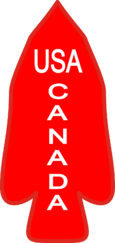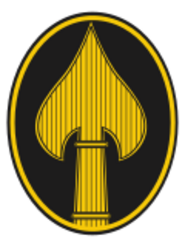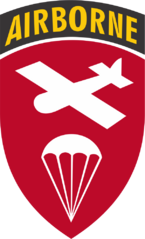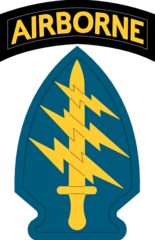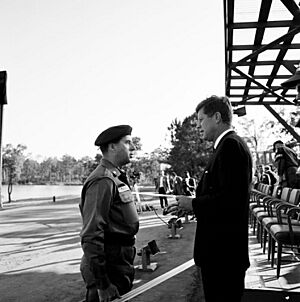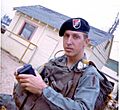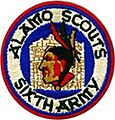History of the United States Army Special Forces facts for kids
The U.S. Army Special Forces are a special group of soldiers in the United States Army. They are known for their special skills in unconventional warfare. This means they can fight in unusual ways, often behind enemy lines. They work with local groups to help them fight against a bigger, stronger enemy.
The idea for the Special Forces came from earlier special units. These included the Alamo Scouts and the First Special Service Force. Another important group was the Operational Groups (OGs) from the Office of Strategic Services (OSS). Many Army soldiers served in the OSS. Their experiences helped shape the Special Forces.
During the Korean War, some former guerrilla leaders helped create the Special Forces. Col. Wendell Fertig and Lt. Col. Russell W. Volckmann used their wartime knowledge. They helped develop the ideas for unconventional warfare. These ideas became key to the Special Forces' mission.
In 1951, Major General Robert A. McClure chose Colonel Aaron Bank to lead a special operations branch. Colonel Bank had also been part of the OSS.
In June 1952, the 10th Special Forces Group (Airborne) was formed. Colonel Aaron Bank was its first commander. This happened soon after the Psychological Warfare School was set up. Today, that school is called the John F. Kennedy Special Warfare Center and School.
The 10th Special Forces Group was later split. Some soldiers went to Bad Tölz, Germany, in September 1953. The rest stayed at Fort Bragg. They formed the 77th Special Forces Group. In May 1960, this group became today's 7th Special Forces Group.
Since 1952, Special Forces soldiers have served in many places. These include Vietnam, Panama, Afghanistan, and Iraq. They also helped in countries like Syria and East Africa.
Contents
What Are the Special Forces?
The Special Forces are often called "Green Berets." This is because of the green beret hat they wear. Their history goes back over 200 years. They follow in the footsteps of famous American fighters. These include "Swamp Fox" Francis Marion from the American Revolutionary War.
The Special Forces motto is De oppresso liber. This is Latin for "to free the oppressed." It shows their main goal. They help people in occupied countries fight for their freedom. They train and lead local fighters, often called guerrillas.
How Were the Special Forces Created?
Some parts of the Office of Strategic Services (OSS) were similar to the Special Forces. The OSS had "Jedburgh Teams." These were small, three-person teams. They worked with the French Resistance during World War II. They helped lead these groups against the enemy.
Another important unit was the First Special Service Force. This was a joint unit of Canadian and American soldiers. It was formed in 1942. Members of this force were later honored for their role in Special Forces history. Each year, a special exercise called Menton Week celebrates this link.
Some early Special Forces leaders learned a lot from fighting in the Philippines. They were involved in guerrilla operations there during World War II. These experiences helped them create the Special Forces' ideas for unconventional warfare. Leaders like Russell W. Volckmann and Colonel Wendell Fertig used what they learned.
The Korean War started in 1950. It showed the U.S. military that they needed better special warfare skills. Units like the United Nations Partisan Forces Korea operated behind enemy lines. Their experiences also helped shape the Special Forces.
The Special Forces were officially formed in 1952. They were first part of the U.S. Army Psychological Warfare Division. This division was led by Brigadier General Robert A. McClure. He believed that psychological warfare and unconventional warfare were connected.
The 10th Special Forces Group was formed in June 1952. Colonel Aaron Bank, known as the "father of Special Forces," commanded it. This group's formation happened at the same time as the Psychological Warfare School. This school is now the John F. Kennedy Special Warfare Center and School.
Colonel Bank had worked with OSS units during World War II. He advised and led French Resistance groups before D-Day in 1944.
The 10th Special Forces Group moved to Bad Tölz, Germany, in September 1953. The soldiers who stayed at Fort Bragg, North Carolina, formed the 77th Special Forces Group. This group later became the 7th Special Forces Group in 1960.
The Special Forces became a permanent part of the U.S. Army on April 9, 1987.
Women in the Green Berets
In 1981, Captain Kathleen Wilder became the first woman to qualify for the Green Berets. She faced some challenges, but it was later confirmed she had met all the requirements. In 2020, the first woman officially joined the Green Berets as an active member.
Images for kids
-
US Army Green Berets firing on an insurgent sniper position during a joint patrol with Afghan commandos in Wardak Province, October 9, 2011.
-
A Special Forces operator in Syria with a special dog provides security during the Deir ez-Zor campaign, October 11, 2018.


